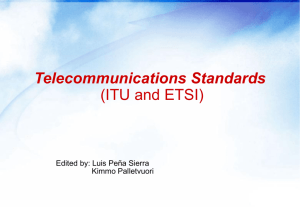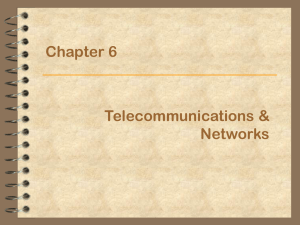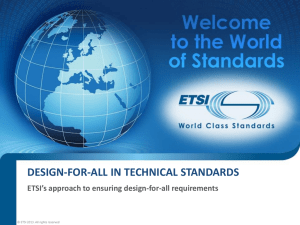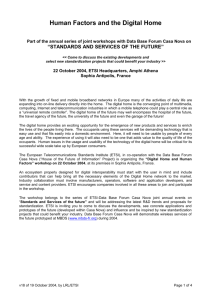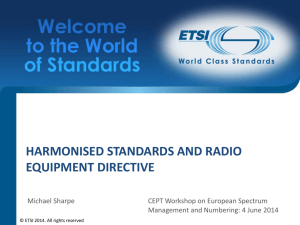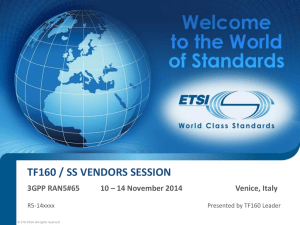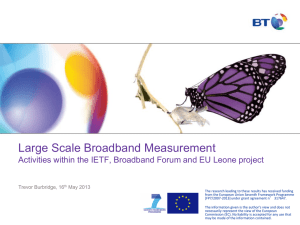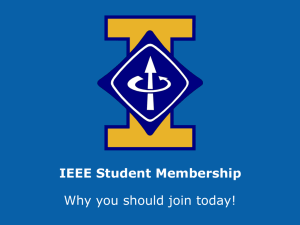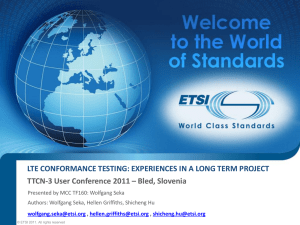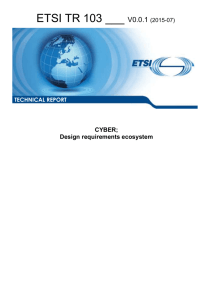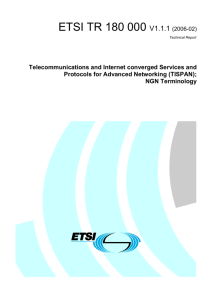telecommunications network
advertisement
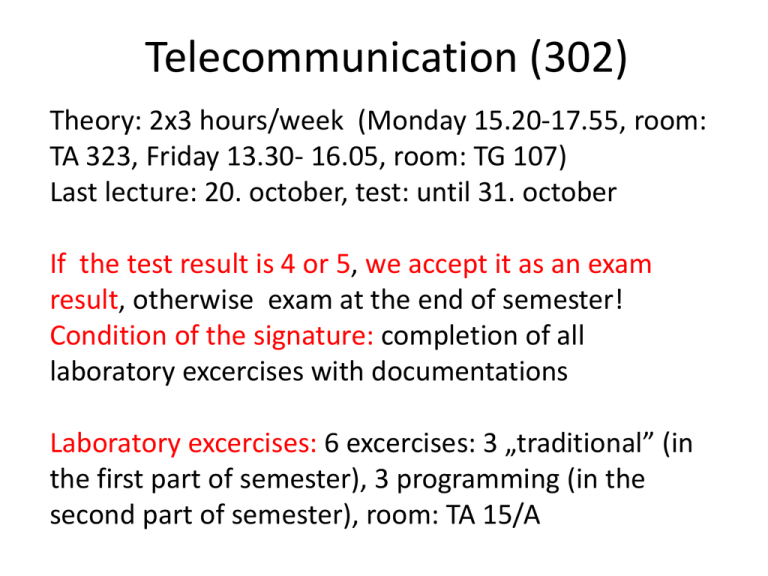
Telecommunication (302) Theory: 2x3 hours/week (Monday 15.20-17.55, room: TA 323, Friday 13.30- 16.05, room: TG 107) Last lecture: 20. october, test: until 31. october If the test result is 4 or 5, we accept it as an exam result, otherwise exam at the end of semester! Condition of the signature: completion of all laboratory excercises with documentations Laboratory excercises: 6 excercises: 3 „traditional” (in the first part of semester), 3 programming (in the second part of semester), room: TA 15/A Telecommunication Instructor responsible: Dóra Maros Theory: 39 hours Teachers: Dóra Maros: standardization, concepts(6 hours) Tibor Gudra: networks basics (12 hours) Péter Antók: optical networks (3 hours) György Lukács: radio transmission (6 hours) Sándor Gyányi : IP (9 ) József Kármán: network management (3 hours) Test: 2 hours Specifications, Standardization and Related Bodies Szabályozási szervezetek Standardization Bodies WORLD International Telecommunication Union International Electrotechnical Commission International Organization for Standardization EUROPE European Telecommunications Standards Institute Comité Européen de Normalisation Électrotechnique; Other Important Organizations Institute of Electrical and Electronics Engineers International Federation for Information Processing Internet Engineering Task Force International Telecommunication Union (www.iti.int) ITU (International Telecommunication Union) is the United Nations specialized agency for information and communication technologies – ICTs.. 193 Member States, ITU membership includes ICT regulators, leading academic institutions and some 700 private companies. Goals: allocate global radio spectrum and satellite orbits, develop the technical standards that ensure networks and technologies seamlessly interconnect, and strive to improve access to ICTs to underserved communities worldwide. International Telecommunication Union International Telecommunication Union Sectors Sectors: ITU-R: Radiocommunication ITU-T: Telecommunication Standardization ITU-D: Telecommunication Development https://www.youtube.com/watch?v=S_BCkvTM4wk ITU-R The ITU Radiocommunication Sector (ITU-R) plays a vital role in the global management of the radiofrequency spectrum and satellite orbits. Global Management of services (land, sea, sky): •fixed, mobile telecommunications •broadcasting •amateur radio •space research •emergency telecommunications •meteorology •global positioning systems •environmental monitoring and communication services ITU-T Assemble of experts from around the world to develop international standards known as ITU-T Recommendations which act as defining elements in the global infrastructure of information and communication technologies (ICTs). Standards are critical to the interoperability of ICTs and whether we exchange voice, video or data messages, standards enable global communications by ensuring that countries’ ICT networks and devices are speaking the same language. ITU-D Core mission: foster international cooperation and solidarity in the delivery of technical assistance and in the creation, development and improvement of telecommunication equipment and networks in developing countries. Most important projects: Climate change: Facilitating carbon emission reductions and monitoring, mitigating impact and adapting to change. Emergency telecommunication: Maximizing the contribution of ICTs to disaster predication, detection and coordination. Cyber security: Fostering the integrity of ICT systems that is essential for their continued development. And others like: Regulatory & market environment (e.g roaming), ICT applications (e-health, e-government), Digital Inclusion (special solutzions for persons with disabilities, children etc.) ITU Study Groups (SG) ITU-R ITU-T (2013-2016) ITU-T Documents ITU-T Recommendations: so called normative documents (more than 4000) ITU-T Recs have non-mandatory status until they are adopted in national laws. Technical papers (SG reports, case studies etc) Handbooks (on operation, network planning, quality of service, implementation guidelines) European Telecommunications Standards Institute European Telecommunications Standards Institute (www.etsi.org) Officially recognized by the European Union as a European Standards Organization. ETSI is a not-for-profit organization with more than 750 ETSI member organizations drawn from 63 countries across 5 continents worldwide. ETSI Membership (www.etsi.org) Nemzeti Média és Hírközlési Hatóság European Telecommunications Standards Institute ETSI Products and Services (www.etsi.org) European Telecommunications Standards Institute Different types of ETSI standards Different types of documents allows us to meet the variety of needs within the different industries we serve: European Standard (EN) – Used when the document is intended to meet needs specific to Europe and requires transposition into national standards, or when the drafting of the document is required under a mandate from the European Commission (EC)/European Free Trade Association (EFTA). An EN is drafted by a Technical Committee and approved by European National Standards Organizations. ETSI Standard (ES) – Used when the document contains technical requirements. An ES is submitted to the whole ETSI membership for approval. ETSI Guide (EG) – Used for guidance to ETSI in general on the handling of specific technical standardization activities. It is submitted to the whole ETSI membership for approval. European Telecommunications Standards Institute Different types of ETSI standards ETSI Technical Specification (TS) – Used when the document contains technical requirements and it is important that it is available for use quickly. A TS is approved by the Technical Committee that drafted it. ETSI Technical Report (TR) – Used when the document contains explanatory material. A TR is approved by the Technical Committee that drafted it. ETSI Special Report (SR) – Used for various purposes, including to make information publicly available for reference. An SR is approved by the Technical Committee which produced it. ETSI Group Specification (GS) – Provides technical requirements or explanatory material or both. Produced and approved within our Industry Specification Groups (ISGs). European Telecommunications Standards Institute IMPORTANT! HOW we can find technical specifications? IF YOU'RE INTERESTED IN THE TECHNICAL SPECIFICATIONS AUTHENTIC SOURCES ALWAYS WORK! Use ETSI documentations libary! ALL STANDARDS ARE AVAILABLE ON WEBPAGE AND FREE OF CHARGE! Let’s look: www.etsi.org ETSI Clusters European Telecommunications Standards Institute ETSI clusters provide a simple, easy to grasp overview of ETSI activities in ICT standardization. grasp: to understand sth completely Third Generation Partnership Project Technical Committees 3GPP specialised for mobile broadban standards 3GPP the Main Body of Mobile Communicatons Standards Members : 3GPP produces Technical Specifications, to be transposed by relevant Standardization Bodies (Organizational Partners) into appropriate deliverables (e.g., standards). 3GPP Specifications Releases and Numbering The RELEASE is a group of specificitaions. First was R99 (about 2000)! Then: R4…..R12 (Better way to find mobile standards!) Internet Engineering Task Force www.ietf.org IETF is a large open international community of network designers, operators, vendors, and researchers concerned with the evolution of the Internet architecture and the smooth operation of the Internet. It is open to any interested individual. Memos in the Requests for Comments (RFC) document series contain technical and organizational notes about the Internet. They cover many aspects of computer networking, including protocols, procedures, programs, and concepts, as well as meeting notes, opinions. IETF WG-k www.ietf.org Working Groups (WGs) work on special fields: IETF RFC www.ietf.org Eye-triple-E Institute of Electrical and Electronics Engineers www.ieee.org •IEEE is the world's largest professional association dedicated to advancing technological innovation and excellence for the benefit of humanity. •Its members inspire a global community through IEEE's highly cited publications, conferences, technology standards, and professional and educational activities. •IEEE’s roots go back to 1884 when electricity began to become a major influence in society. There was one major established electrical industry, the telegraph, which since the 1840s had come to connect the world with a data communications system faster than the speed of transportation. IEEE Membership Institute of Electrical and Electronics Engineers www.ieee.org more than 430,000 members in more than 160 countries, more than 50 percent of whom are from outside the United States; more than 120,000 Student members from 80 countries; 333 sections in ten geographic regions worldwide; 432 affinity groups - IEEE Affinity Groups are non-technical sub-units . Eg. IEEE-USA Consultants' Network, Graduates of the Last Decade Young Professionals (YP), Women in Engineering (WIE), and Life Members (LM). IEEE Xplore Institute of Electrical and Electronics Engineers http://ieeexplore.ieee.org/ Date: 7 September 2014 Journals from 1872! IEEE Xplore Standards Institute of Electrical and Electronics Engineers http://ieeexplore.ieee.org/ xpl/standards.jsp IEEE standards Institute of Electrical and Electronics Engineers www.ieee.org The best known IEEE standard is IEEE 802.11 WLAN Hungarian Authority www.nmhh.hu Nemzeti Média és Hírközlési Hatóság Its task is to ensure the undisturbed operation, in compliance with pertaining legislation in force, of the media and the markets for electronic communications, postal and information technology services. The Authority has an active role in the work of international organisations: ITU, ETSI, IETF and others NMHH Main Activities Nemzeti Média és Hírközlési Hatóság Legistlation: Becoming familiar with the most important items of Hungarian legislation on the regulation of electronic communications, postal services, and the regulation of the IT and media markets (acts and decrees). Official statements: Statements include publication of notices on given procedures where the law requires publication through notice. Statements describing the details of given procedures and calling attention to them in this way help accurate high-standard fulfilment of provisions of law and supply of current information to the consumers and customers. NMHH Main Activities Nemzeti Média és Hírközlési Hatóság Frequency management: is an activity performed in order to ensure the undisturbed operation of radio communications and other, non-telecommunications services Services, appliances, constructions: the authority accepts and judges the notifications of services in conformity with legal prescriptions, registers the services and service providers belonging to its competence, determines the obligatory technical and operational conditions for sake of integrity of the communications network. NMHH Main Activities Nemzeti Média és Hírközlési Hatóság Numbering: the numbers, addresses and the ranges of those needed for operation of communications networks and for the provision of services - the identifiers – are scarce resources. The available identifiers are registered in the national allocation plan of identifiers which stipulates the distribution of all the identifiers among the activities and services, the type, allocation and dimension of identifiers. E-signature, E-advertisement: supervises the services and service providers connected with the electronic signature, and checks the operation of the organizations appointed for certifying the conformance of the electronic signature products. NMHH Main Activities Information on market: •Communicaton market data, reports, •Market analysis, •Market surveillance, •Communication statistic database, •Market research Telecommunications Networks and their Scope Telecommunication Networks Network part which the end user does not see much Telecommunication Networks User part which the operator does not see much …and between.. which no one can see anything Telecommunication Networks Definition The electronic transmission of information over distances, called telecommunications, has become virtually inseparable from computers. Computers and telecommunications create value together. The information may be in the form of voice telephone calls, data, text, images, or video. Today, telecommunications are used to organize more or less remote computer systems. A telecommunications network is an arrangement of computing and telecommunications resources for communication of information between distant locations. Telecommunication Networks Geographical Scope 1. Terminals for accessing the network 2. Computers that process information and are interconnected by the network 3. Telecommunications links that form a channel through which information is transmitted from a sending device to a receiving device. 4. Telecommunications equipment that facilitates the transmission of information. 5. Telecommunications software that controls message transmission over the network. Geographical Scope Wide Area Network Metropolitan Area Network Local Area Network Personal Area Network Techniques in radio communicaton Computer networks Basic topologies Wide Area Network Swicthing 1. Leased line: Point-to-Point connection between two computers or Local Area Networks (or users), fix monthly fee Safe but expensive (e.g ATM bank automats) 2. Circuit switched, (SC): A dedicated circuit path is created between end points. Best example is dialup connections (phone call) Slow, not too expensive Wide Area Network Swicthing 3. Packet swiched (PS): The information is sent in separated packets Connection oriented: Devices transport packets via a shared single point-to-point or point-to-multipoint link across a carrier internetwork. Before information can be exchanged between two endpoints, they first establish a Virtual Circuit. Variable length packets are transmitted Connectionless: Between endpoints no connection is build; endpoints can just offer packets to the network, addressed to any other endpoint and the network will try to deliver the packet. As an example: the Internet Wide Area Network Swicthing 4. Cell relay : Similar to packet switching, but uses fixed length cells instead of variable length packets. Data is divided into fixed-length cells and then transported across virtual circuits Before 2000 this was seen as the best option for simultaneous use of voice and data. (ATM: Asynchronous Transfer Mode) Circuit Switching (CS) Phone call (fix, mobile) Data (modem) Problems: lf Switching node is overloaded the connection is not established If connection is established, services quality is good! Packet Switching (PS) Internet (fix, mobile) Data, voice (VoIP), video, audio Problems: packet delay, congestion in nodes Connection established, but some packets are lost (causes bad quality) Cell relay (outdated) Multiple Access, MA FDMA (Frequency Division Multiple Access) TDMA (Time Division Multiple Access) CDMA (Code Division Multiple Access) 1 channel = 1 frequency 1 channek = 1 timeslot 1 channel = 1 code ITime Time Time Frequency Frequency NMT 450 GSM Frequency UMTS MA: Many users share a common resource Multiple Access, MA OFDMA 4G mobile and Wlan Space Division Multiple Access, SDMA 4G-5G futute networks FDMA and TDMA FDMA: user on different frequency subbands to share the available bandwith TDMA: user on same frequency subbands but in different times (timeslots) CDMA transmitter using DS CDMA • Users transmit on same frequency band in the same time, the original info is multiplied by a special code • Each user has a unique code C1-Cn: channek codes spreading Power Backround noise f(Hz) s1(t) Pseudo-zaj 1 STX c1(t) f(Hz) Modulator Power f(Hz) s2(t) f(Hz) c2(t) Pseudo-zaj 2 Power f(Hz) ∑ Acos(ωct) Power f(Hz) sn(t) f(Hz) cn(t) Pseudo-zaj 3 DS: Direct sequence S Tx [ s1 ( t ) c1 ( t ) s 2 ( t ) c 2 ( t ) ... s n ( t ) c n ( t )] A cos w c t CDMA receiver using DS CDMA Channel despreading means the multiplication (XOR) of channel signel and the channel code. Received channel Received signal f(Hz) Processing gain fc = c/2 fc = c/2 The received signal is the SUM of all channels on the carrier frequency Band filter Demodulator SRX c1(t) S Rx ( t ) c1 ( t ) [ s1 ( t ) c1 ( t ) s 2 ( t ) c 2 ( t ) ... s n ( t ) c n ( t )] A cos w c t c1 ( t ) ' n S Rx ( t ) c1 ( t ) [ s i ( t ) c i ( t ) c1 ( t ) ] A cos w c t s1 ( t ) c1 ( t ) c1 ( t ) A cos w c t ' ' i2 interference Channel c i ( t ) c1 ( t ) 1, c1 ( t ) c1 ( t ) 1 Channelization Codes (I.) Auto-correlation and cross-correllation for digital codes ACF (AC Function): → L lengh bit sequence and its shifted version is compared ACF CC NCC CC: Number of Equal bit in the same position NCC: Number of not Equal bit in the same position CCF (CC Function): two totally different bit sequence is compared CCF bit by bit Orthogonal codes: CCF = 0 CC NCC Chanellization Codes (II.) Walsh code • Walsh, or Walsh-Hadamard codes: • Codes are orthogonal in the same matrix (CCF = 0) • Walsh matrix: n x n matrix 8 Wi m: matrix size i: matrix row (0…n) m 0 M2 0 M1 0 M 2N M M 0 0 M4 0 0 0 1 N M N N M N 0 0 1 0 0 1 1 1 0 1 1 0 W1 0 0 0 0 0 1 0 1 0 0 1 1 0 1 1 0 M8 0 0 0 0 0 1 0 1 0 0 1 1 0 1 0 01 0 11 0 11 0 0 0 0 0 1 0 0 0 1 0 1 1 1 1 1 1 0 1 1 1 0 1 0 0 0 1 1 0 1 0 0 1 CDMA FH-Frequency hopping FH: Many subbands, transmittion hops between carriers For each user a sequence of frequencies is allocated, there is no the same carrier for two or more channels at the same time Channel B: 7-9-1-14-10-5-13-2-11 Channek C: 9-2-4-11-8-14-10-6-3 OFDMA (Orthogonal Frequency Division Multiple Access Subcarrier are orthogonal, they don’t disturb each other LTE (4G) spectrum: one user transmits on two or more subcarriers Narrow band and wide band transmission Narrow band GSM channel Bandwidth: 200 KHz Wide band 3G UMTS channel Bandwidth: 5 MHz OFDMA vs. FH CDMA OFDMA: more carriers for one user at the same time FH CDMA: one carrier for one user in different times Channel 1: A-F Channel 2: C-H Channel 3: C-H Single Carrier and Multi Carrier Systems t1 (c1) t3 (c3) t2 (c2) TDMA: Different timeslots CDMA: Different codes f1 f2 f3 f4 FDMA: one user, one carrier f1 f1 f2 f3 f4 f5 f1 f2 f3 f4 f5 t1 OFDMA: more then one carriers at the same time t2 t1 t2 t3 t3 FH: more carriers, transmission is hopping Duplexing (mobil) B(dl):bandwidth Downlink FDD: Uplink-downlink fr. Bands (2G és 3G) fk(dl) B(ul) Uplink fk(ul): middle frequency Uplink Downlink time B(dl)=B(ul) fk(dl)-fk(ul)= duplex distance TDD: same carrier for UL and DL (4G) Duplexing (ADSL) FDD vs. TDD f keretidő t f Guard band t Traffic problems in the network Connection is not establish because no free channel, (1) tipical in mobile cells. Connection is not establish because the switching node (2) is overloaded. Connection is not establish because the transmission lines (3) are overloaded. 3 1 2 Traffic problems in the network The cause of congestion: accident (softver upgrade) Traffic problems in the network The cause of congestion: some users need bigger bandwidth (youtube, on-line games etc) Car vs Truck Traffic problems in the network The cause of congestion: (maintenance in the network) Thank you for Attention!
